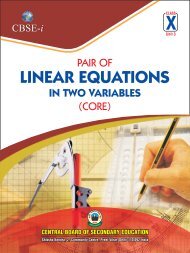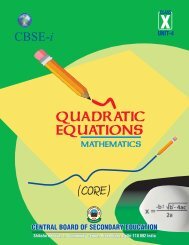CBSEi Class 10 Sequences (AP and GP) CORE
CBSEi Class 10 Sequences (AP and GP) CORE
CBSEi Class 10 Sequences (AP and GP) CORE
You also want an ePaper? Increase the reach of your titles
YUMPU automatically turns print PDFs into web optimized ePapers that Google loves.
Thus, the sum of first n terms of an <strong>AP</strong> is given by<br />
Sn = [2a + (n 1) d]<br />
Note that<br />
last term of the <strong>AP</strong> = = a+(n 1) d.<br />
Let = a + (n 1) d.<br />
So, , = [2a + (n 1) d]<br />
= [a + a + (n 1) d]<br />
= [a + ]<br />
Hence = [a+ ],<br />
where is the last term or nth term.<br />
The above method is similar to the one used by the great German mathematician Carl<br />
friedrich Gauss (1777-1855) when he was in elementary school. His teacher asked the<br />
class to find the sum of first <strong>10</strong>0 natural numbers. Gauss found the sum as follows:<br />
1 + 2 + 3 + 4 + ………… + 98 + 99 + <strong>10</strong>0<br />
<strong>10</strong>0 + 99 + 98 + 97 + ……….... + 3 + 2 + 1<br />
<strong>10</strong>1 + <strong>10</strong>1 + <strong>10</strong>1 + <strong>10</strong>1 + ………… + <strong>10</strong>1 + <strong>10</strong>1 + <strong>10</strong>1<br />
<strong>10</strong>1, <strong>10</strong>0 times<br />
i.e., sum = = 5050<br />
61

















